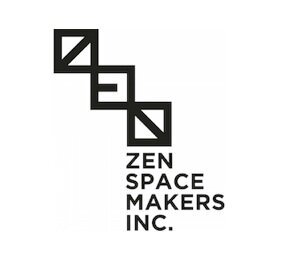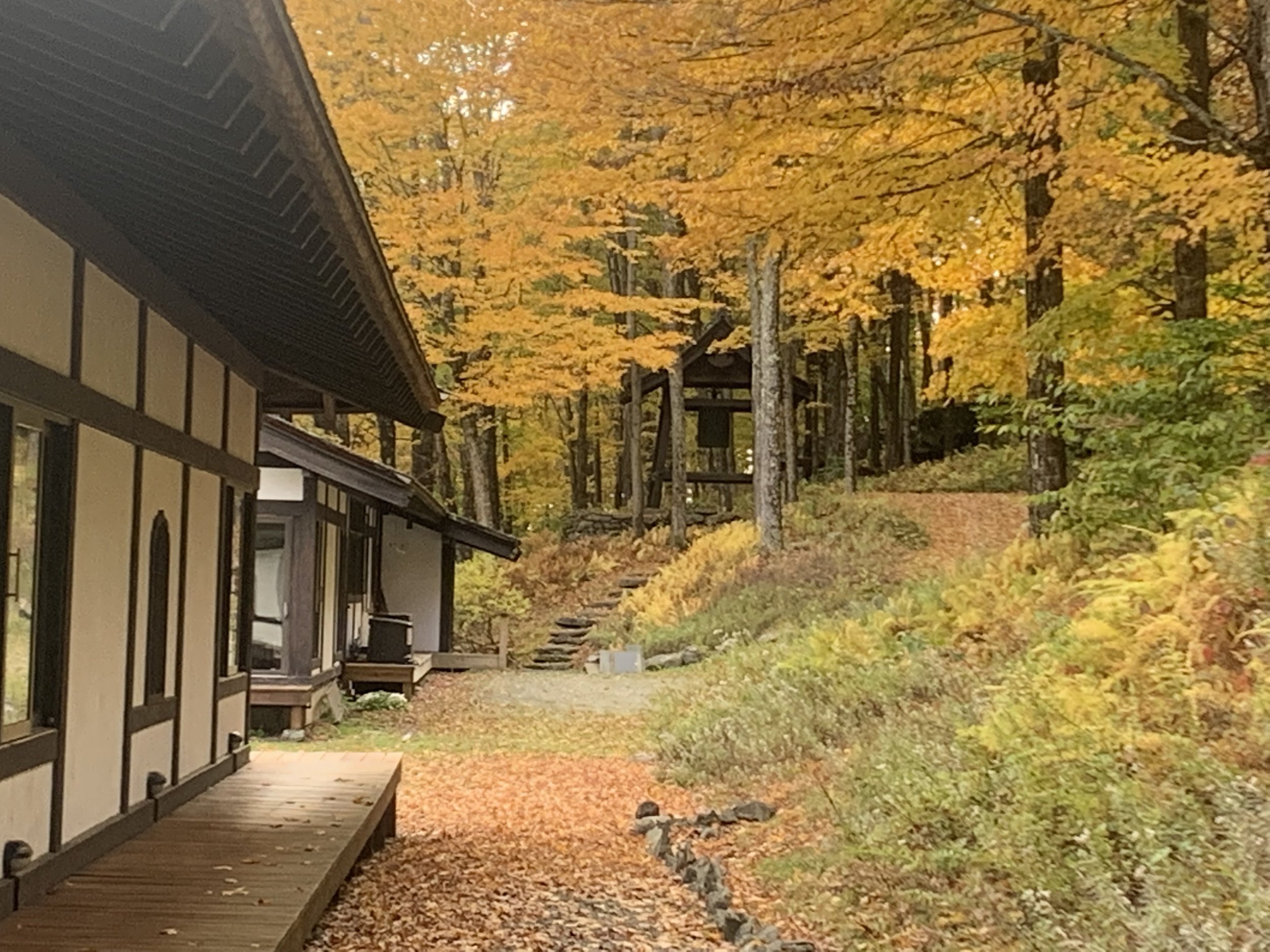Golden Wind Axioms
for Zen Space Makers
Notes From Golden Wind Sesshin, October, 2022
Dai Bosatsu Monastery
By Sho-An Sander Hicks
1. How you do the little things is how you do everything.
This is not original, but somehow I really got this, in a new way, this past week at “Golden Wind Sesshin” the retreat I just did, at Dai Bosatsu Zendo, in the Catskills. The attention paid to little things means everything. This tiny insight made me want to bring this small reminder into the company, and make big impacts, with the flutter of a butterfly.
I meditated a lot, and also got coaching from Zen Master Chigan Roshi. He is so fresh and funny. There was also a double helping for me: of “work meditation.” Every morning, I cleaned the Men’s Bathroom, and after every lunch I cleaned the dining room. There, I saw we only really used ⅔ of the long tables for eating. But I found that it paid off to wipe down all table surfaces. Why not go all the way? In fact there is no other way than all the way. All the way is the basic standard. Otherwise, there may be dust left behind. And then a mad monk would call me out!
2. “The master stroke always involves the out breath.”
This one is from the past, a few years ago, at one of my first retreats at DBZ. The Senior Monk, Shin Kon, taught a quick class about “Misogi” breathing, which is a practice from Aikido and Zen. You practice how extreme you can push yourself, to breathe in all the way, and then go even further than that. You breathe out all the way, and go even further than that. It is pretty wild. You see stars. You bring more attention to your breath, instead of ignoring it all day, or taking it for granted. Shin Kon said, you can do this as a part of your meditation.
But there was one other thing I remember he said. And this I have used this axiom, a lot. It changed everything. It is about the control the body has, with the “out breath.” He said, “The master sword-smith, the master potter, they execute their coup de grace on the out breath.”
I recall recently giving archery tips to a young cousin at a family gathering. I told her to release the arrow on the out-breath. She did. It must have helped her focus, by making the archery more physical and less cerebral. She hit the bullseye. She was pleased. Since emotions help you remember things, I hope she holds that memory as fondly as I do.
3. Release tension.
I asked the Zen Master, why do I keep thinking of jokes to tell the final gathering of the retreat, during the retreat? Why do I keep living in that future moment, telling bad jokes?
He had this insight: people joke because of underlying tension. Where is the tension coming from?
I sat with that for days. This was deep in the middle of the Sesshin at this point. I was able to find the tension in my body and release it. When there was mad pain in my legs, I thought of it as a carpentry clamp, with a “quick grip lever to tighten it, and a tight trigger to release it.”
“Release the clamp” became my mantra. I later did tell some jokes at the gathering, but mostly I reflected miracles from nature that I had observed. The way the local mockingbird imitated the striking of the dharma drum. Nature had picked up our rhythm.
4. Communicate Visually.
As a company, ZSM has gotten great at communicating visually with clients. Now we need to extend that kind of care to communicating visually with each other, from project managers to workers, with drawings, sketches, and 3D renderings.
5. Clean the Ceiling
It’s funny: I cleaned the bathroom thoroughly, the walls, the floors, the toilets and sinks, every day. I thought I had done a good job. Then Alec came by and asked me to clean the ceiling. I looked up, and it was filthy! Cobwebs, and schmutz in the web! Even soot from way back then the Zendo furnaces used to burn green firewood. I cleaned the ceiling that day. With a hot wet rag. And the next day, I went over it again with a squeegee on a rod. I am reminded of the words of the late great Zen teacher Junpo Roshi. “The Zen work ethic demands us to polish everything twice. The Protestant Work Ethic is nothing compared to the Zen work ethic.” (Source: Junpo Roku, a great book of his teachings and talks.)
6. Get Complete
This one from Landmark, really, a practice that started influenced by Zen. From that training, I long to “get complete” with people I have worked with, if there may be any lingering resentment, if things did not work out. And yet I can’t force the “getting complete” based on my own ego and needy sensitivity. This one is an open question for now.
7. Meditate
I wrote 12 rules of Zen Carpentry back in 2011, when I first stopped drinking, and I started doing Zen. I spray painted “Zen Carpentry” on my van, and that was an act of writing a new reality, coming into a new era, through the spray paint inscription of two simple words. I made a commitment to do yoga and meditation daily as a part of Zen Carpentry. I am grateful to F. who worked with me briefly and pushed me to start every day with five minutes of silent meditation. A return to Zen Carpentry principles.
8. Yoga Practice
Recently I worked with J.P. and he didn’t have any construction experience at all. But he was a former yoga teacher, and it was so good to have him as a part of the crew, even if it was brief. The work that we do is physically grueling. Yoga helps to release tension, and untie knots. I remember one morning I had stiffness in my neck, and he had a quick bunch of neck and shoulder and arm stretches for us to do. The whole crew joined in. We all needed it.
9. Save Materials
We had a client recently. She had a heavy cement Buddha outside on her deck. Buddha was sitting on the ground. I saw this as a need, to give her Buddha a home, to give her a random act of kindness. To start off our relationship on the “right path.” And since I am a pack rat and like to save materials, I used materials from the big house renovation in NJ. Including plywood and aluminum from the roof, and solid catalpa from the shop. I have made so many altars for people, this one had a special quality of ease, of “no effort.” I was able to delegate and have the crew work a little bit on each part. We made this while we were making something else. And it came out beautifully. She loves it.
10. Re-Use Materials
We used to buy everything at “Big ReUse” the construction salvage place. I have come to think it’s more “professional” to buy new lumber. But what do the trees think?
11. Build Housing for the Poor and for the Workers
I need to say it clearly like that so that the influences of the world don’t swirl in and cloud the vision. I care about affordable housing, like so many activists. But unlike most, I have a construction company, and we are growing. And as Zen Space Makers, starts to speak and plan larger development projects, I meet potential allies and partners, some of whom show me their own plans to help investors buy a large complex of apartment buildings in Texas, and the plan there is to raise rents by 20%. Reminds me of back home in South Brooklyn, with our new tenants association, up against the new owners of the building, who are tightening the screws on all of us. They bought a building worth $5.3 MM for $8 MM. Why. It’s clear. They are betting on getting rent-stabilized people out, and younger, richer people in. It’s not fair, and that’s not who I want to be. So the call becomes clearer. Zen Space Makers does not wish to become capitalist real estate developers. We see a way to build housing for the workers or the world, the poor, the wandering barefoot monks of New York. Housing with compassion, and a cooperatively owned Food Co-op at the ground floor.







